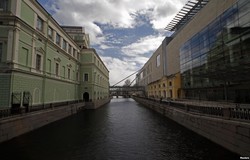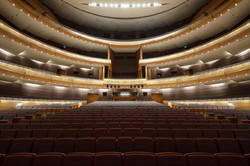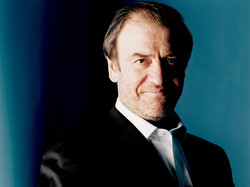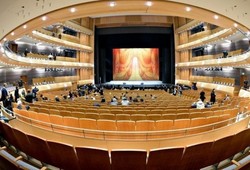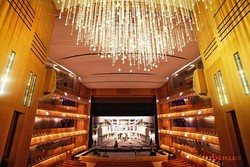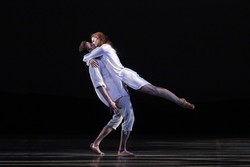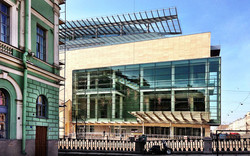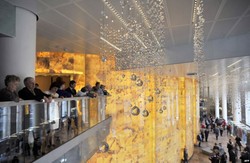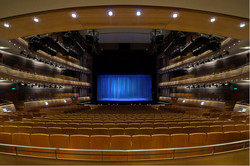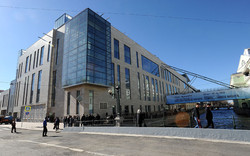|
| Mariinsky II (New Theatre)We all hope that the opening of the Mariinsky II will once again confirm and strengthen the great traditions of our theatre, opening the path to a future where it will be possible to stage the most contemporary works and innovative productions, productions of which we could not even have dreamed before.
The repertoire of Mariinsky II aims to demonstrate the supreme art of the performers in our companies and our wonderful stage, linking the history of the Mariinsky Theatre with contemporary audiences and with contemporary works from the diverse genres of opera, ballet and symphonic music.
The artistic opportunities available to the whole theatre – the opera and ballet companies, chorus and orchestra – will expand exponentially. After all, the Mariinsky II, the historic building and the Concert Hall together form a unique cultural complex. The new building with its main stage equipped with the very latest technology, and its three chamber venues, will create the most amazing conditions in which to bring to life daring artistic ideas and educational projects as well as chamber vocal and instrumental programmes.
We will be able to expand our audience base to tens of thousands, and millions more people will be able to see broadcasts of performances and concerts across Russia’s regions and throughout the world. We will be broadcasting special programmes for schools, libraries and cultural centres throughout the country, reaching the most far-flung corners. These broadcast projects are aimed, first and foremost, at children and young people.
The new theatre opens up new and incredible possibilities for us all. I truly believe that.
Valery Gergiev, Artistic and General Director of the Mariinsky Theatre
The Mariinsky II in the world press:
Mariinsky II is a good thing. With its 2,000 seats and carefully engineered acoustics, the theatre offers impressive technical flexibility. (The Economist)
The auditorium is excellent: like Glyndebourne’s bigger brother, with light wood balconies, fine acoustics and superb sightlines. Backstage the theatre is a city in itself: linked by various passages, the stages, workshops and rehearsal rooms accommodate the entire staff of the Mariinsky (2500 people) with ease. Here it is possible to work on five productions at the same time or with the click of a mouse bring huge sets onstage. (The Times)
The prime mover behind St Petersburg’s shiny new opera house, Mariinsky II, had put his fabled drive and energy to the test by conducting five shows in three days. Thursday’s exhausting opening gala was well chosen and brilliantly played, sung and danced. The brisk, brilliant two-hour tour de force was the perfect calling card for the new venue but turned out to be just a warm-up for a three-day musical marathon. (The Telegraph)
Within the airy interior are beige marble and Swarovski crystal lights, with backlit walls of translucent onyx and picture windows affording city views (...) The auditorium is a magnificent horseshoe creation of beech and oak, with scalloped ceiling and slatted box fronts edged with crystal to leaven the solidity of the whole. (The Telegraph)
The new theater, while generic from the street, has a restrained glamour in its public spaces, dominated by the glowing onyx exterior wall of the auditorium. Inside the mood is coolly elegant, the theater’s blond wood far simpler than the opulent old Mariinsky without seeming plain.
It seems to have, as Mr. Gergiev predicted before the opening, acoustics that are more platinum in color than the warm, immediate gold of the old house. The sound in Mariinsky II can seem a bit distant, but it is clear and well blended, with prominent winds and brasses that manage not to swamp the strings. (The New York Times)
Mariinsky II Fact Sheet
The building, covering 79114 m2, is one of the largest theatre and concert venues in the world. The auditorium seats up to 2000 people at full capacity. There new theatre has seven storeys above ground and three below. There is the main stage, a rehearsal stage and backstage premises; rehearsal rooms for the ballet company, the opera company and the orchestra; premises for 1000 various members of staff; chamber venues and premises in the foyer which house educational projects for children and young people; a rooftop amphitheatre which is to be a venue for the Stars of the White Nights festival; and underground car parking for staff.
Alongside the historic building of the Mariinsky Theatre, built in 1860, and the Concert Hall which opened in 2006, the Mariinsky II forms part of this theatre and concert complex, unique in its artistic and educational capabilities. This complex reiterated the status of the Mariinsky Theatre as one of the world’s most important cultural institutions.
Exterior
The exterior of the building is made of beige Jura limestone, interspersed with syncopated floor-to-ceiling windows of various sizes, and a metal roof. These windows will afford, from outside, a view of the theatre’s inner foyer and, from the inside, of the Kryukov canal. A glass and steel canopy extends over the main entrance to the theatre (the corner of Dekabristov St and the Kryukov Canal).
Foyer
The main foyer, with its two levels, features rear-lit onyx stone walls that surround the auditorium and Emperador marble floors. Jura beige limestone walls frame the various windows that look onto Dekabristov Street and the Kryukov canal. Thanks to the surrounding glass façade, the foyer will be illuminated during the day by an abundance of natural light. For evening performances, custom-designed Swarovski chandeliers will illuminate the space. The main foyer provides unique views of the Mariinsky Theatre across the canal.
Public areas have been designed as an integral and complementary component of the building and create a sense of dramatic arrival and fluid movement. A variety of staircases thread through the foyer, including a dramatic 33-metre architectural glass staircase that traverses the north side of the foyer, connecting every above-ground level of the building. The foyer is split into several individual spaces of various sizes.
The lobby amphitheatre, located on the 3rd floor, will serve as an additional space for educational projects, interactive programmes for children and young people, chamber music concerts and artistic exhibitions.
Auditorium
While the auditorium is a contemporary hall, its principles are those of famous 18th and 19th century opera houses, with a horseshoe shape and three balcony levels. This configuration has proved to be ideal for intimacy, acoustics, sightlines, audience comfort and overall cohesion of the hall.
The sculptured beech balcony fronts are shaped by acoustical demands. The use of three balconies instead of four allows for more height between levels and creates better sound dispersion, especially for the rows located farther back.
The production lighting meets the latest demands of artistic productions while Swarovski accent lights are studded in the balcony fronts and are designed to give sparkle to the hall, as small candelabras once did in old theatres.
Carefully selected with acoustic considerations in mind, the floors of the auditorium are oak parquet on a wooden substructure with gypsum perimeter walls and ceilings.
Auditorium seats are fabricated by Estel Group in Italy. The fabric was manufactured by Danish Art Weaving.
The VIP box contains beech wood balcony fronts, leather walls and a Swarovski chandelier.
Stage
The new hall will have a main stage and a rehearsal stage, along with ample supporting areas divided by acoustic doors and curtains. The three stage areas can merge to become a single stage or be used independently, depending on the scale and technical requirements of the performance.
Stage Equipment
The stage machinery selected for the new theatre means that it will be utterly unique. The theatre can offer an essentially endless series of performances, rehearsals and installations of productions. The stage machinery has been designed and installed specifically to ensure this endless working process as well as the greatest possible functionality.
When developing the concept of the stage space, the most exemplary contemporary analogies were used, as have been the best practices of recently built or recently renovated theatres throughout the world. The reconstruction practices and greatest technical solutions at London’s Royal Opera House, Copenhagen’s Royal Opera, Paris’ Théâtre du Châtelet and many other theatres have been employed.
The stage space has been broken down into individual zones, each of which fulfils its own strictly defined function. This includes the main stage, backstage, the side pockets, the rehearsal stage, the installation zone and the loading and unloading zone with its component assembly area. This division of space makes it possible to have the sets for at least four productions in the stage area at the same time. Moreover, at the same time, the main stage can be hosting the most technically demanding production in terms of sets, the rehearsal stage a full-scale rehearsal, the sets for the next performance can be assembled in the installation zone and other sets loaded or unloaded in the cargo dock.
The stage is equipped with a system of rolling platforms and compensators, rising and falling platforms and fixed point hoists. All machinery elements are automated and are used via a control panel. This means the theatre will be able to host incredibly bold productions and the company will be able to work without any technical limitations whatsoever.
Orchestra Pit
The orchestra pit is equipped with a moveable acoustic wall developed to allow for varying orchestral and acoustic needs. At full capacity, the pit is 170 m2 and holds up to 120 musicians.
The pit is also equipped with three platforms: a smaller one in the rear and two larger ones in the front. These can be raised or lowered to different levels depending on the instrumentation and the desired sound.
Acoustics
The Mariinsky II has been designed to create ideal acoustic conditions. At about 18000 m3, the hall has an ideal volume and is comparable to the world’s most renowned opera houses.
The auditorium’s floor is separated from the concrete foundations by sound-absorbing wooden structures.
Solid wood balustrades arranged in an overlapping sequence with embedded light fixtures are located throughout the auditorium to aid sound diffusion.
Uniquely designed 2 to 3 metre pieces of concave plaster have also been installed throughout the auditorium to disperse sound the sound better.
The modulated surfaces of these inclined wall claddings are a modern-day version of the decorative elements found in historic opera houses to improve acoustics.
Rehearsal Spaces
The new theatre incorporates numerous spacious rehearsal areas, including ones for the ballet company, the orchestra and chorus as well as large multifunctional rehearsal rooms and additional individual rehearsal rooms. Rehearsal room walls and ceilings are clad in special veneered and sound-absorbing panels.
Open-air terrace
During summer, starting one hour before performances commence, it is possible to visit the roof terrace of the Mariinsky-II, from which patrons may see beautiful panoramic views of the historic centre of St Petersburg. Excursion tickets are available at the box-office of the Mariinsky-II or from the duty administrator one hour before the start of a performance on presentation of a valid ticket for that performance.
|
Tomorrow at the Main Stage
|
 Mariinsky Theatre:
Mariinsky Theatre:  Mariinsky-2 (New Theatre):
Mariinsky-2 (New Theatre):  Mariinsky Concert Hall:
Mariinsky Concert Hall: 

